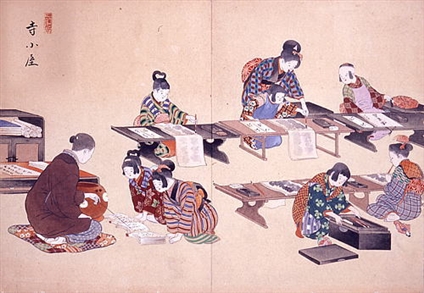Confucianism and Samurais
Samurais of Japan were not simply warriors, though the sword was a symbol that proved a samurai status of each samurai.
They were originally from guards of the imperial court in Kyoto. But they gradually took over power from the imperial court and the noble class to set up their own regime in the 12th century.
Since then, the samurai class governed Japan till 1860s when the last samurai regime led by the Tokugawa clan fell. As leaders of the nation, they had to acquire some culture ranging from Japanese and Chinese classics, Buddhism, Confucianism, Shintoism, and various types of art. As samurais also became bureaucrats in the central government and officials in office of local samurai lords, they also learnt financing and technology.
In the samurai era of Japan, intellectual persons belonged to the noble class living in Kyoto, the samurai class, Buddhist monks or Shinto priests, or rich merchants or farmers. Especially in the Edo period of Japan (from the early 17th century to 1860s), 100% of samurais could read and write while 50% of other people, including farmers, could also read and write, since small private schools and temple schools were set up in almost every village and town.

A small private school for children of farmers, craftsmen, and merchants in the Edo era
http://www.edojidai.info/sikijiritu.html
When the Tokugawa clan seized political power and hegemony all over Japan after the age of provincial wars that lasted for one and half centuries, Tokugawa shogun adopted a school of Confucianism as de facto national learning. They spotlighted an aspect of Confucianism that put emphasis on the relationships between the ruler and subjects, masters and servants, parents and children, and men and women to strengthen social order. They put samurais at the highest position in the social hierarchy, farmers at the second position, craftsmen at the third position, and merchants at the fourth. The Tokugawa shogun is situated at the top of the social structure almost in parallel with the emperor. They used teaching of Confucianism to establish and fix the class society in Japan governed by samurais of various clans.
So, before Westernization and modernization of Japan that started in 1860s, Japanese had been cultivated by Confucianism in addition to Buddhism in terms of spiritualism. Though Christianity was openly introduced to Japan after Meiji Restoration of 1868, this religion could not prevail due to deeply rooted Buddhism and Confucianism.
What is a point at issue is that Japanese samurais and especially the last samurai regime governed Japan not only by swords but also by Confucianism, though it was one unique school of Confucianism.
So, the moral code of the Japanese people of even today is rooted in Confucianism. However, influences of Confucianism are different among China, Korea, and Japan. So, these nations have not necessarily kept good relationships. Yet, Japanese are spiritually closer to Chinese and Koreans who are also historically under influence of Confucianism than Europeans and Americans who have nothing to do with Confucianism.
One of popular teachings of Confucius among samurais is: Masters should behave like masters; subjects should behave like subjects; fathers should behave like fathers and children should behave like children.
Of course, men should behave like men and women should behave like women.
Indeed, the Son of Man, Christ Jesus, behaved like the Son of God.
In addition, samurais were expected to die like samurais, so that they sometimes commit a suicide by disembowelment or perform hara-kiri (seppuku) if a need arose.
Incidentally, it seems that descendants of ex-samurais interestingly account for a majority of Japanese Christians of today for some reasons.
**** **** ****
Luk 6:5 And he said unto them, That the Son of man is Lord also of the sabbath.
